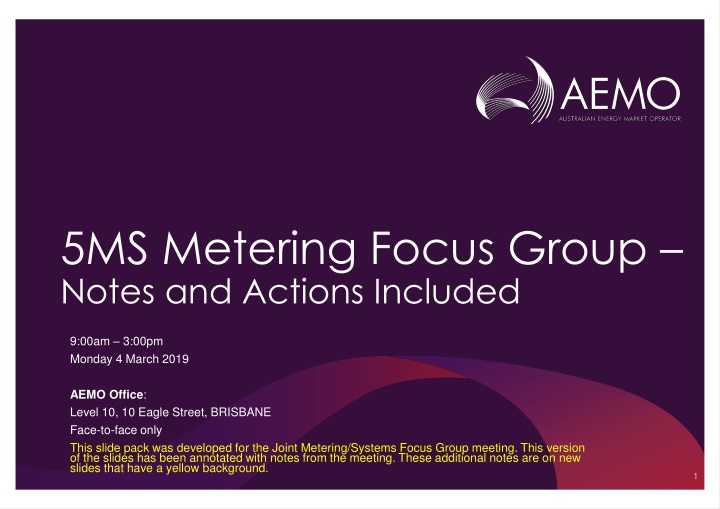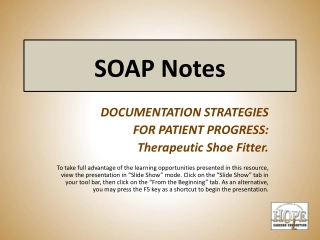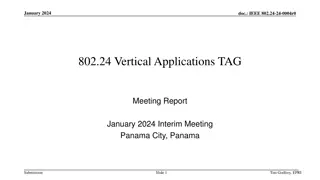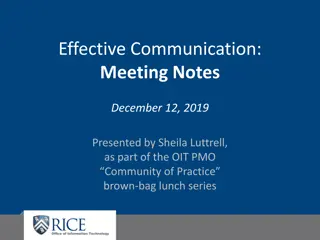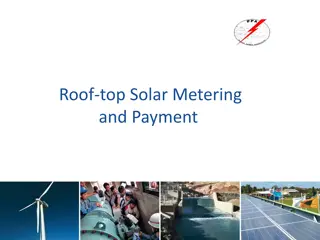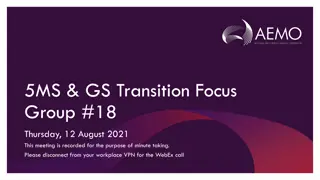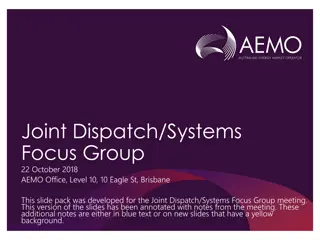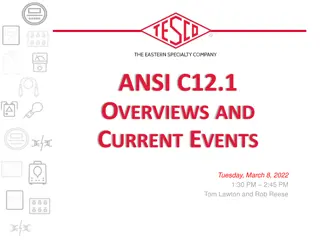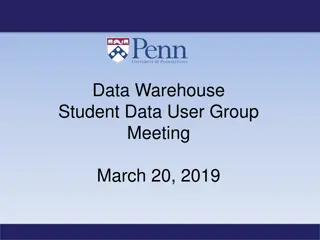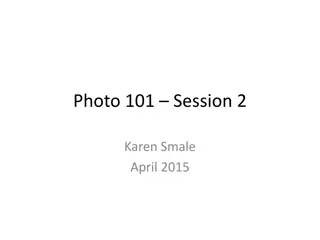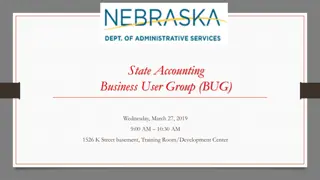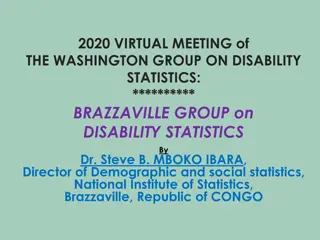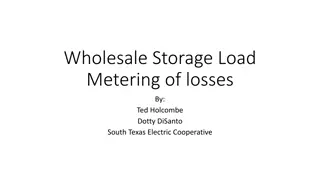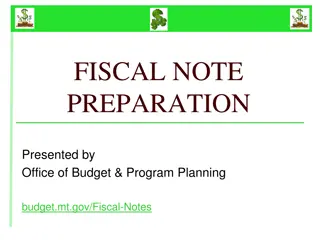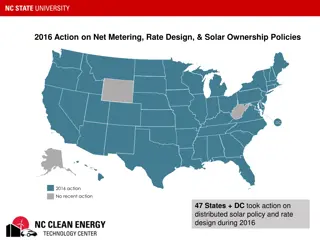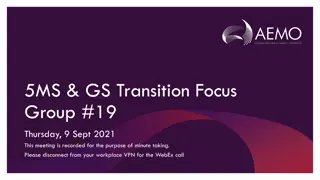5MS Metering Focus Group - Meeting Notes and Actions, 4 March 2019
Presentation created for the in-person 5MS Metering Focus Group meeting at AEMO Office in Brisbane to discuss metering and systems topics. The meeting will be held on Monday, 4 March 2019, from 9:00 am to 3:00 pm at Level 10, 10 Eagle Street. The slide pack includes important notes and planned actions for the joint session.
Download Presentation

Please find below an Image/Link to download the presentation.
The content on the website is provided AS IS for your information and personal use only. It may not be sold, licensed, or shared on other websites without obtaining consent from the author.If you encounter any issues during the download, it is possible that the publisher has removed the file from their server.
You are allowed to download the files provided on this website for personal or commercial use, subject to the condition that they are used lawfully. All files are the property of their respective owners.
The content on the website is provided AS IS for your information and personal use only. It may not be sold, licensed, or shared on other websites without obtaining consent from the author.
E N D
Presentation Transcript
5MS Metering Focus Group Notes and Actions Included 9:00am 3:00pm Monday 4 March 2019 AEMO Office: Level 10, 10 Eagle Street, BRISBANE Face-to-face only This slide pack was developed for the Joint Metering/Systems Focus Group meeting. This version of the slides has been annotated with notes from the meeting. These additional notes are on new slides that have a yellow background. 1
Attendees NAME COMPANY / DEPARTMENT NAME COMPANY / DEPARTMENT Emily Brodie AEMO Mark Riley AGL Energy Limited Blaine Miner AEMO Shawn Tan Energy Australia David Ripper AEMO Stephanie Lommi Red Lumo Simon Tu AEMO Taran Nanda Origin Energy Jim Agelopoulos AEMO Victor Sanchez Infigen Robert Speedy AEMO Ty Crowhurst IntelliHub Alex Polonetskiy Ausgrid Justin Stute Mondo Jane Hutson Energy QLD Alex Skaria Flow Power Chantal Wright Momentum Energy Mark Leschke Metering Dynamics Dino Ou Endeavour Energy Jackie Mayo Metering Dynamics Divya Kapoor Flow Power Jeff Roberts Evoenergy Doug Miles Origin Paul Greenwood Vector Jonathon Briggs Metering Dynamics Mark Pilkington Citipower/Powercor Justin Betlehem AusNet Services Paul Willacy Aurora Energy Linda Brackenbury PlusES 2
Agenda NO TIME AGENDA ITEM RESPONSIBLE Preliminary Matters 9:00am - 9:15am Welcome, Introduction and General Housekeeping Blaine Miner (AEMO) 1 Matters for Noting and Discussion 9:15am - 10:45am Metering Procedure Changes Package 1 David Ripper (AEMO) 2 10:45am - 11:00am Break 11:00am - 11:45am Global Settlements Blaine Miner (AEMO) 3 11:45am - 12:15pm Metering Procedure Changes Package 2 David Ripper (AEMO) 4 12:15pm 12:45pm Lunch 12:45pm 1:15pm Metering Procedure Changes Package 3 David Ripper (AEMO) 5 1:15pm - 1:45pm File size and communications capabilities Jim Agelopoulos (AEMO) 1:45pm - 2:00pm Break 2:00pm 2:30pm Reconciliation Support Blaine Miner (AEMO) 7 2:30pm 3:00pm Additional Time for Agenda Items, Other Business and Next Steps Blaine Miner (AEMO) 8 3
Metering Procedure Changes Package 1 Blaine Miner 4
Metering Procedures Update Package 1 Consultation First Stage Consultation First Stage Consultation AEMO received 15 submissions (including two late submissions) from Retailers, LNSPs, Meter Providers, Meter Data Providers and intending participants. AEMO identified three material issues The proposed profiling approach for 15 and 30-minute interval meters Changes to the delivery of meter data to AEMO Industry standard optical port performance and the volume of metering data stored in a metering installation. Jurisdictional amendments to the Metrology Procedures, submitted to AEMO by the COAG Energy Council, were also included in the Draft Procedure changes Second Stage/Draft Consultation Second Stage/Draft Consultation AEMO received 11 submissions from Retailers, LNSPs, Meter Providers, Meter Data Providers and intending participants. 5
Package 1 - Material Issues Material Issue The proposed profiling approach for 15 and 30-minute interval meters Description AGL questioned how 30- minute small customer generation (e.g. solar) should be profiled to five- minute levels and how this profiling would ultimately impact the net system load profile (NSLP). AEMO Analysis Broad support was received for AEMO s proposed profiling approach for 15 and 30-mintute meter reads. AEMO Conclusion As no preferred alternative has been identified, AEMO will maintain its proposed profiling approach. The magnitude of any imbalance that occurs within a 15 or 30-minute period is likely to be small in comparison to the imbalances that occur across a 3-month accumulation reads. AGL had undertaken some initial analysis of five-minute and 30-minute solar data and determined that there could be at least a 10% error rate. Its analysis also suggested that the error rate would be greater during the dusk and dawn periods, coinciding with increased consumer usage. No alternative profiling approach was proposed by AGL or other stakeholders. 6
Package 1 - Material Issues Material Issue Changes to the delivery of meter data to AEMO Description AEMO Analysis AEMO Conclusion AEMO proposed to more closely align the MDP s meter data delivery processes for AEMO and market participants. Stakeholder feedback supported AEMO s objective to more closely align the MDP s meter data delivery processes. AEMO supports the alignment and uniformity of meter data delivery by MDPs to AEMO and other market participants. Proposed changes: Lower level granularity of meter data, being provided to AEMO, is becoming more important in supporting its core functions, Global Settlements, as well as supporting emerging initiatives such as Distributed Energy Resources and Consumer Data Rights. - MDFF NEM12 files to be the required file format for all interval meter data being delivered to AEMO from 1 July 2021 - NEM12 meter data to be delivered to AEMO as per the meter s configuration i.e. 5, 15 or 30min from 1 July 2021 AEMO recognises the potential challenges certain stakeholders may have in fully aligning meter data delivery processes for Basic meter data reads. - NEM12 register level and reactive meter data to be delivered to AEMO from 1 July 2021, even where the CATS NMI Data Stream records are at the Net level AEMO believes that the transition to MDFF for Basic meter reads should be implemented progressively over an appropriate period of time. 7
Package 1 - Material Issues Material Issue Changes to the delivery of meter data to AEMO Description AEMO Analysis AEMO Conclusion AEMO proposed an arrangement that seeks to align the delivery of meter data for market settlement with existing formats used for B2B Stakeholder feedback has been very strong in supporting AEMO s objective to more closely align the MDP s meter data delivery processes to AEMO and market participants. Proposed changes: - Net datastream records to be progressively replaced by Register level data stream records in the CATS NMI Data Stream (CNDS) table Granularity of meter data, being provided to AEMO, is becoming more important in supporting its core functions, as well as supporting emerging initiatives such as Distributed Energy Resources and Consumer Data Rights. - MDFF NEM13 files to be supported by AEMO from 1 July 2021 however AEMO will continue to support and accept MDMF files for Basic meter reads - Meter data to be delivered consistently by MDPs to both AEMO and market participants AEMO recognises the potential challenges certain stakeholders may have in fully aligning meter data delivery processes for Basic meter data reads. AEMO believes that certain alignments may be best implemented progressively over an appropriate period of time. 8
Interim Net Read Construction Solution Leverages the 4 fields highlighted below to interpret the meter data being received and constructs Net meter data where required e.g. CNDS record is Net (N1) and we receive suffix E1, the system will see that the NMI config is E1 and Q1 and will know to create Net meter data values based on the E1 reads received to support current energy allocation processes MDPs can send MDFF to AEMO without having to first update CNDS standing data records Where the CNDS data stream is Net and the required NMI config register level meter data has not been received, a Net meter read estimate is calculated and an exception report is sent to the MDP.
Interim Solution Use Cases Case #1 Case #1 Description Description Scenario Net CNDS Suffix with E1 and B1 meter reads Use Case - N1 is registered in the CNDS. - MDFF file is sent to AEMO containing CSVIntervalData for IntervalValue1 with the following meter data: - A read with MDMDataStreamIdentifier = N1 and a NMISuffix = B1. - A second read with MDMDataStreamIdentifier = N1 and a NMISuffix = E1. - Two reactive load reads for K1 and Q1. - The 4 reads in the CSVIntervalData will be loaded as B1, E1, K1, Q1. - A sign shall be applied to the loaded register level reads based on the first character of the NMISuffix. - 'E1' for IntervalValue1 = (+) 10.000 - 'B1' for IntervalValue1 = (-) 2.000 - Sign change applied due to the first character of the suffix B1 being an B. - A 5th N1 read shall be created. - N1 shall be constructed from E1 and B1 reads that share the same NMI, IntervalDate and MDMDataStreamIdentifier. - E1 - B1 = N1 . - (+) 10.000 - 2.000 = (+) 8.000 N/A Meter Data Load Exception Reporting Settlements - At settlements the CNDS registered data stream N1 shall be assessed - As N1 exists for IntervalValue1, N1 shall be read from the loaded meter data - (+) 8.000 shall be used as the settlement actual ((+) 10.000 - 2.000 = (+) 8.000) N1 CNDS Suffix
Interim Solution Use Cases Case #2 Case #2 Description Description Scenario Net CNDS Suffix with no E1 or B1 meter reads Use Case - N1 is registered in the CNDS. - MDFF file is sent to AEMO containing CSVIntervalData for IntervalValue1 with the following reads: - Two reactive load reads for K1 and Q1. - No reads for the MDMDataStreamIdentifier that has been supplied. - The 2 reads in the CSVIntervalData will be loaded as K1, Q1. - No net read shall be constructed. - RM11 report generated to highlight missing N1 Meter Data Load Exception Reporting Settlements - At settlements the CNDS registered data stream N1 shall be assessed - As N1 does not exist for IntervalValue1, an estimate for the N1 data stream shall be used for settlements based on the NMI like-day read or ADL N1 CNDS Suffix
Interim Solution Use Cases Case #3 Case #3 Description Description Scenario Net CNDS Suffix with missing B1 meter reads Use Case - N1 is registered in the CNDS - MDFF file is sent to AEMO containing CSVIntervalData for IntervalValue1 with the following reads: - A read with MDMDataStreamIdentifier = N1 and a NMISuffix = E1 - The NMISuffix B1 defined in NMIConfiguration has not been supplied - Two reactive load reads for K1 and Q1 - The 3 reads in the CSVIntervalData will be loaded as E1, K1, Q1 - A sign shall be applied to the loaded register level reads based on the first character of the NMISuffix - 'E1' for IntervalValue1 = (+) 10.000 - A 4th N1 read shall be loaded - N1 shall be constructed from E1 - E1 = N1 . - (+) 10.000 = (+) 10.000 - Meter Data Response will highlight missing B1 based on the NMIConfiguration with reads delivered Meter Data Load Exception Reporting Settlements - At settlements the CNDS registered data stream N1 shall be assessed - As N1 exists for IntervalValue1, N1 shall be read from the loaded meter data - (+) 10.000 shall be used as the settlement value - In this use case the N1 may not truly representative of the energy allocations for the NMI N1 CNDS Suffix
Interim Solution Use Cases Case #4 Case #4 Description Description Scenario Register level CNDS Suffix with E1 and B1 meter reads Use Case - E1 and B1 is registered in the CNDS - MDFF file is sent to AEMO containing CSVIntervalData for IntervalValue1 with the following reads: - A read with MDMDataStreamIdentifier = E1 and a NMISuffix = E1 - A read with MDMDataStreamIdentifier = B1 and a NMISuffix = B1 - Two reactive load reads for K1 and Q1 - The 4 reads in the CSVIntervalData will be loaded as E1, B1, K1, Q1 - A sign shall be applied to the loaded register level reads based on the first character of the NMISuffix - 'E1' for IntervalValue1 = (+) 10.000 - 'B1' for IntervalValue1 = (-) 2.000 - Sign change applied due to the first character of the suffix B1 being an B - As the CNDS Suffix is at the register level, no Net read needs to be constructed N/A Meter Data Load Exception Reporting Settlements (+) 8.000 shall be used as the settlement value ((+) 10.000 + (-) 2.000 = (+) 8.000) CNDS Suffix E1 and B1 E1 and B1
Interim Solution Use Cases Case #5 Case #5 Description Description Scenario Register level CNDS Suffix with missing B1 meter reads Use Case - E1 and B1 is registered in the CNDS - MDFF file is sent to AEMO containing CSVIntervalData for IntervalValue1 with the following reads: - A read with MDMDataStreamIdentifier = Null and a NMISuffix = E1 - The NMISuffix B1 defined in the CNDS has not been supplied - Two reactive load reads for K1 and Q1 - The 3 reads in the CSVIntervalData will be loaded as E1, K1, Q1 - A sign shall be applied to the loaded register level reads based on the first character of the NMISuffix - 'E1' for IntervalValue1 = (+) 10.000 - As the CNDS Suffix is at the register level, no Net read needs to be constructed - RM11 report generated to highlight missing B1 Meter Data Load Exception Reporting Settlements - (+) 10.000 shall be used as the E1 settlement value - B1 will be estimated for settlements and stored against the NMI with a (-) sign E1 and B1 E1 and B1 CNDS Suffix
AEMO Responses to Draft Determination Submissions - Changes to Meter Data Delivery to AEMO 15
AEMO Responses to Draft Determination Submissions - Changes to Meter Data Delivery to AEMO Participant Participant Feedback Feedback AEMO Response AEMO Response AusNet Proposal for the use of non-energy register level data from 1 July 2021 has not been justified. Non-energy register level data is only typically used for demand tariff network billing. It is not a billable quantity in the NEM wholesale markets which AEMO operates. Improved power factor will reduce technical losses in the network and consequently contribute to the reduction of UFE. The provision of reactive energy components will allow AEMO to correlate such UFE reductions with improved network utilisation when preparing the UFE reports that are mandated by the NER. 16
AEMO Responses to Draft Determination Submissions - Changes to Meter Data Delivery to AEMO Participant Participant Feedback Feedback AEMO Response AEMO Response Citipower/ Powercor Page 12 of the Draft Report and Determination under section Meter Data Frequency states MDPs must put in place processes to ensure meter data version alignment between AEMO and other market participants . CitiPower Powercor seeks clarification re what is meant by version alignment? Does it mean if an MDFF file is rejected by AEMO & not the retailer (or vice versa)? The intention of this statement is to elicit feedback from MDPs as to how they can best support the alignment of meter data versioning between AEMO and other market participants e.g. MDPs put processes in place to ensure that if meter data is to be sent to one interested party, for example as a response to a PMDR, that all interested parties receive the meter data. Correct. Page 12 of the Draft Report and Determination under section Meter Data Granularity states Net data stream records to be progressively replaced by Register level data stream records in the CATS NMI Data Stream (CNDS) table, with the aim of having a sunset period for this transition to occur CitiPower Powercor seeks clarification re the above statement whether it is intended to imply both: - New interval meters (from 01/07/2021) will only have E1, B1, Q1, K1 or similar datastreams in the CNDS table, and - Existing interval meters will have their N1, N2, datastreams in this table replaced by E1, E2 etc. datastreams progressively replaced from 01/07/2021 All new datastream records are to be created at the register level from 1 July 2021. Existing Net datastream records can remain active post 1 July 2021 until an update to the Datastream record is required e.g. meter replacement. Where an update is required, the Net datastream is to be inactivated and any new datastreams records are to be created at the register level. 17
AEMO Responses to Draft Determination Submissions - Changes to Meter Data Delivery to AEMO Participant Participant Feedback Feedback AEMO Response AEMO Response Energy Queensland Supports the gradual transition of Net data stream records to register level data streams but would like to see a more structured time-line applied to this, and an indication of how the MPBs and MDPs would coordinate updates to the CATS NMI Data Stream table so the MDM Contributory Suffix on the Meter Register is kept in-line with Data Stream changes. All new datastream records are to be created at the register level from 1 July 2021. Existing Net datastream records can remain active post 1 July 2021 until an update to the Datastream record is required e.g. meter replacement. Where an update is required, the Net datastream is to be inactivated and any new datastreams records are to be created at the register level. AEMO are not proposing any changes to the current coordination between MDPs and MPBs. The reception of register level active (kWh) and reactive (kVarh) meter data has been allowed for within the scope of AEMO s 5MS system design. Meridian/ Powershop We are supportive of AEMO being able to receive additional metering (register level and non-energy) data provided that it does not impose significant additional obligations on Participants (e.g. should be optional) and it does not result in significant changes to AEMO s core systems. Consequently we are comfortable with the option of provision of non-energy data and the provision of register level data if AEMO continues to provide participants with NET data (whether provided directly from the MDP or calculated by AEMO from register level data). AEMO would like to further understand the comment regarding AEMO continuing to provide participants with NET data (whether provided directly from the MDP or calculated by AEMO from register level data). . 18
AEMO Responses to Draft Determination Submissions - Changes to Meter Data Delivery to AEMO Participant Participant Feedback Feedback AEMO Response AEMO Response Plus ES Disagrees with the proposed need for the MDP to continue to have to manage datastreams for meter data delivered at a register level. PLUS ES takes this position for the following reasons: - a. NMI Suffixes are currently maintained in MSATS by the MPB within the NMI Meter Register table. The population of this information is mandatory. b. Obligations currently exist on the MPB and MDP to manage the accuracy and consistency of register and suffix information within the NMI Meter Register table. Refer MSATS Procedures clauses 2.4 (k), 2.4 (q), 2.5 (a) c. Obligations currently exist on the MDP to align information contained within the MDFF with MSATS (ie Register IDs). This obligation only exists for type 4, 4A and 5 metering installations, but could easily be expanded to all metering types. d. Retailers currently validate metering data supplied in the MDFF against the NMI Meter Register table. This is common practice among most retailers. e. The duplication of suffix and register information in the Datastream table is an unnecessary overhead and will likely lead to confusion and discrepancies The fundamental redesign of MSATS is not within the scope of the 5MS project. Therefore, the 5MS project is not proposing to change the current obligations between MDPs and MPBs, regarding the maintenance of the CATS Register Identifier and Datatsream tables. 19
AEMO Responses to Draft Determination Submissions - Changes to Meter Data Delivery to AEMO Participant Participant Feedback Feedback AEMO Response AEMO Response Plus ES Disagrees with placing an obligation on MDPs to provide metering data associated with reactive energy unless the supply of such metering data is required to support the settlement process. Metering data for reactive energy is collected for all WIGS and LARGE customers, and a relatively insignificant number of SMALL customers. In most cases, both import and export reactive energy flows are measured to support the network tariff. In the majority of instances, the energy measured against the import channel (K1) is zero. The inclusion of this metering data, where it is not required to support the settlement process places an unnecessary increase on the volumes of data being sent to MSATS. AEMO s requirements are changing, in part, as a result of the Global Settlement Rule, New clause 3.15.5B Reporting by AEMO of unaccounted for energy trends. Improved power factor will reduce technical losses in the network and consequently contribute to the reduction of UFE. The provision of reactive energy components will allow AEMO to correlate such UFE reductions with improved network utilisation when preparing the UFE reports that are mandated by the NER. 20
AEMO Responses to Draft Determination Submissions - Changes to Meter Data Delivery to AEMO Participant Participant Feedback Feedback AEMO Response AEMO Response Red/Lumo AEMO did not respond to our questions, we again request clarification on: 1. What validation processes and issues has AEMO considered? 2. How will the rejection process work? Who is notified? 3. Will the notification processes also be amended? If AEMO rejects a file is the FRMP notified 1. MTRD validations shall either be: a. An extension of existing MDMT validations b. New validations based on the MDFF specification. The MTRD MACK and TACK shall be returned as 2 separate files where the MACK shall contain aseXML & message validations and the TACK contains MDFF, standing data & Replacement Read validations. As AEMO expects to receive MDFF each time the MDP resends a MTRD transaction, some existing MDMT validations will need to be relaxed to prevent unnecessary market messaging. Where a rejection occurs the sending MDP will receive the MACK & TACK. Upon sending the correcting MTRD transaction the MDP shall send the MDFF file to all Participants (AEMO, FRMP, LNSP, etc.) in a manner similar to the PMD/VMD process. No, the notifications process is not expected to be amended. 2. 3. 21
AEMO Responses to Draft Determination Submissions - Changes to Meter Data Delivery to AEMO Participant Participant Feedback Feedback AEMO Response AEMO Response Red/Lumo Clarifications requested regarding the provisioning of energy and non-energy meter data to AEMO: 1. What information pertaining to energy or non-energy is being proposed? And for what purpose would AEMO or other market participants require non-energy information? 2. Participants currently pay through contractual agreements for the provision of non-energy data (see PlusES feedback in Stage 1) will AEMO pay for this or will AEMO share all data with the retailer also? 3. How would additional data be stored? what confidentiality requirements would be placed on it? who would have access? Will AEMO s legislated indemnity apply to data that isn t covered under the Rules or Procedures? 4. How will this data be used differently to the current reporting obligation retailers have to AEMO such as Demand Side Participation and being proposed as part of the Distributed Energy Resources Guideline? Could AEMO not meet their UFE obligations from information currently being provided. 5. What additional functions does AEMO see itself performing with the data (energy and non-energy) it receives? Will these functions be completed on a user-pays basis or will the costs of conducting these functions be paid for by all customers? How will AEMO use the additional data if not to perform additional functions? 1. The meter reads to be sent to AEMO would include import and export kWhs (E and B) and import and export kVarhs (Q and K). The provision of active and reactive energy should form part of an MDPs core minimum service. As MDPs are currently paid for these minimum services by FRMPs, AEMO does not believe that any additional cost is justified. The data would be stored in AEMO s MDM solution. Access and treatment of the data would be on the same basis as today. Improved power factor will reduce technical losses in the network and consequently contribute to the reduction of UFE. The provision of reactive energy components will allow AEMO to correlate such UFE reductions with improved network utilisation when preparing the UFE reports that are mandated by the NER. AEMO is proposing to receive this data to create efficiencies to its current core functions, including settlement query/dispute management, as well as fulfilling its NER obligations associated to UFE Trend reporting. 2. 3. 4. 5. 22
AEMO Responses to Draft Determination Submissions - Changes to Meter Data Delivery to AEMO Participant Participant Feedback Feedback AEMO Response AEMO Response Red/Lumo Do not support the reception of register level meter data and firmly believe that this must not be considered for change at this time. AEMO supports the alignment and uniformity of meter data delivery by MDPs to AEMO and other market participants. Uniformity is expected to result in operational efficiencies for MDPs as well as contribute to the reduction of settlement related queries and disputes, which as discussed in the AEMC s Global Settlement Rule consultation represents a significant cost to the industry. AEMO s understanding is that the delivery of register level meter data to AEMO is already allowed for in Chapter 7 of the NER. Are there any other questions or concerns participants believe AEMO have not been addressed? AEMO noted in their draft determination that there was participant support to this initiative however, the multiple concerns and questions from Metering Providers and some retailers that were not addressed. AEMO must not make a new obligation on the provision of metering data without addressing the concerns raised by participants who will ultimately bare the cost of this optional, AEMO led implementation. 23
Package 1 - Material Issues Material Issue Optical port and the volume of meter data storage Description AEMO Analysis AEMO Conclusion Landis+Gyr noted that the requirements outlined in Metrology Procedure Part A clause 3.2, section C, were incompatible with the industry standard optical port and the volume of metering data stored in a metering installation. AEMO agrees that the timeframe to download 90 days of interval metering data, currently stated in Metrology Procedure: Part A clause 3.2(c), may not be achievable for 5- minute metering data. AEMO proposes to change the download to 90 seconds or less per Datastream. 24
Metering Procedure Changes Package 1 - Notes Topic outcomes and discussions: Topic outcomes and discussions: Profiling approach for 15 and 30min meter data Profiling approach for 15 and 30min meter data Agreement that AEMO s profiling approach was suitable for the transition to 5MS and GS. Participants and AEMO noted that as additional 5min meter data became available over time, the profiling approach could be reconsidered e.g. possible inclusion for solar, business and residential profiles. Interim Net Read Construction Solution: Interim Net Read Construction Solution: AEMO presented five net read construction use cases related to the following scenarios: Net CNDS Suffix with E1 and B1 metering data Net CNDS Suffix with no E1 or B1 metering Data Net CNDS Suffix with missing B1 metering data Register level CNDS Suffix with E1 and B1 metering data Register level CNDS Suffix with missing B1 metering data Changes to meter data delivery: Changes to meter data delivery: General acceptance of MDP meter data delivery alignment for AEMO and market participants. Question from Endeavour as to whether MDPs have to re-send all applicable register level data (e.g. E and B) even where only 1 register had changed (e.g. E)? AGL It would make it simpler if MDPs sent all of the registers AEMO will relax the current validation rule that prevents MDP Version Date Time equal to a previously submitted read being summitted. Origin queried the value of CNDS data and suggested that AEMO should instead rely of the CRI table for register level information AEMO responded by saying That Retailer systems do not consistently rely on CRI table information today, some do but others have configured their systems to rely on CNDS data instead, so there is no consistency approach in the market The fundamentals/table construct of MSATS is out of scope of the 5MS program AEMO s Interim Net Read Construction Solution attempted to strike a balance between participant operational impacts and register level settlement transparency AEMO s approach was supported by AusNet Services Feedback that AEMO needs to clearly communicate that it is not compulsory to provide AEMO with non-energy data i.e. any meter data that is not active or reactive energy (E, B, Q, and K) Discussion regarding the potential obligation of an MDP to re-send meter data to all participants when a Retailer requested a PMD or VMD. Endeavour MDPs should only send the data to all participants when the meter data has changed since the last delivered version PlusES - send to all when the data changes Question asked regarding if AEMO would expect for Net Datastreams to be replaced by register level Datastreams in the following use cases (1) Re-Energisation \ De-Energisation (2) ADL calculation AEMO position that any new record created in the register table is the trigger to populate the Datastream table with individual Datastreams that are to be used for settlements. 25
Metering Procedure Changes Package 1 - Notes Actions Actions 1. MFG to provide additional use cases for net read construction. 2. AEMO to follow up with Powershop on comment regarding AEMO continuing to provide participants with NET data (whether provided directly from the MDP or calculated by AEMO from register level data). . and share AEMO s response with MFG 3. AEMO to clarify meter data delivery approach in final determination including: Clarifying that reactive energy K and Q Datastreams are not required for energy settlements and consequently not required in the CNDS Table Reactive energy data is required by AEMO to support AEMO s obligation to analyse and report on UFE in accordance with the Global Settlements Rule. If provided in the Datastream table, MDP must indicate that these are not to be used in settlements Non-energy data is not reactive energy data, non-energy data includes volts ,amps, pf etc. AEMO confirmed that it is not compulsory to send non-energy data to AEMO. 4. AEMO to confirm logic to accept metering data with date/time stamp equal to or greater than validation rather than current greater than validation in order to avoid rejecting actual metering data that is re-sent. 26
Global Settlements Blaine Miner 27
Global settlement implementation timeline 1 July 2021 1 July 2021 5MS begins AEMO starts publishing UFE data 1 March 2022 1 March 2022 AEMO s first annual report on UFE trends 1 December 2019 1 December 2019 AEMO procedures updated for both 5MS and GS 6 February 6 February 2022 2022 GS begins New annual report [NER 3.15.5B] and new reporting guidelines [NER 3.15.5B(d) and 11.112.6] New procedure required [NER 3.15.5(d) and 11.112.5]
Maintain and Receive Standing and Meter Data 1 2 3 4 5 6 7 8 9 Apportion and Allocate UFE Load (Based on Loss Adjusted accounted for Energy) Receive & Investigate Settlement Queries / Disputes Calculate UFE Load by Local Area per Trading Interval Publish Statements, Invoices and Reports Prepare & Publish UFE Trend Analysis / Reporting Maintain and Receive Standing and Meter Data Calculate Energy Purchases & Sales Load Calculate Purchases, Sales and UFE Dollars Action Dispute Outcomes What s changed due to GS? What s changed due to GS? Considerations Considerations All the meter data MDPs deliver today to AEMO, plus Tier 1 accumulation metering data Non-market unmetered loads now in MSATS, including agreed meter data volumes Non-market Unmetered loads to be processed through MSATS The load profile and size to be agreed upon by the customer, DNSP, retailer and AEMO in accordance with AEMO s updated metrology procedures and unmetered load guidelines, including: the methodology for calculating a load and load profile for non- market unmetered load; and the provision of the estimated volumes of non-market unmetered load to AEMO for inclusion in settlement AEMO to update their unmetered load guidelines and metrology procedures in accordance with the rules consultation procedures By 1 December 2019, AEMO must review and where necessary amend and publish the following documents: Market Settlement and Transfer Solution Procedures, Metrology Procedures and Service Level Procedures MDPs to provide meter data for ALL connection points to AEMO Creation and activation of 1st tier NMIS in MSATS Creation, cleanse & activation of associated NMI standing data, Datastreams and Registers Delivery of ALL meter data to AEMO No longer delivering 2nd tier meter data to LR Non-market Unmetered loads to be processed through MSATS Best treatment of non-market unmetered loads e.g. categorisation The creation of NMIs for non-market unmetered loads Creation & activation of associated NMI standing data, Datastreams and Registers Determination of the methodology for calculating a load and load profile for non-market unmetered loads The provision of the estimated volumes of non-market unmetered load to AEMO Updating of unmetered load data tables Delivery of non-market unmetered load meter data to AEMO 29
Calculate Energy Purchases & Sales Load 1 2 3 4 5 6 7 8 9 Apportion and Allocate UFE Load (Based on Loss Adjusted accounted for Energy) Receive & Investigate Settlement Queries / Disputes Calculate UFE Load by Local Area per Trading Interval Publish Statements, Invoices and Reports Prepare & Publish UFE Trend Analysis / Reporting Maintain and Receive Standing and Meter Data Calculate Energy Purchases & Sales Load Calculate Purchases, Sales and UFE Dollars Action Dispute Outcomes What s changed due to GS? What s changed due to GS? Bottom up as opposed to a top down approach Not changing Embedded networks will continue to be settled using settlements by difference within the network Treatment of VTN s is unchanged (primary contributor to UFE being allocated at the Local Area level) VTNs are retained for the purposes of settlement. Considerations Considerations Changes to meter data aggregation process for Settlements purposes 30
Calculate and Allocate UFE Load and Dollars 1 2 3 4 5 6 7 8 9 Apportion and Allocate UFE Load (Based on Loss Adjusted accounted for Energy) Receive & Investigate Settlement Queries / Disputes Calculate UFE Load by Local Area per Trading Interval Publish Statements, Invoices and Reports Prepare & Publish UFE Trend Analysis / Reporting Maintain and Receive Standing and Meter Data Calculate Energy Purchases & Sales Load Calculate Purchases, Sales and UFE Dollars Action Dispute Outcomes What s changed due to GS? What s changed due to GS? UFE = TME - DDME ADME UFE is the total unaccounted for energy amount (in MWh) to be determined TME is the amount of electrical energy, expressed in MWh, flowing at each of the transmission network connection points in the local area in the trading interval DDME is the amount of electrical energy, expressed in MWh, flowing at each of the distribution network connection points in the local area which are connected to an adjacent local area, in the trading interval ADME is the aggregate of the amounts represented by (ME x DLF) for that trading interval for each connection point assigned to the transmission network connection point or virtual transmission node UFE calculated for each local area to be allocated across all market customers in that local area based on their accounted-for energy Considerations Considerations UFE charges now levied on applicable market customers based on their accounted-for energy in a local area Cross boundary/border scenarios Establish NSP2 in MSATS 31
Publish Statements, Invoices and Reports 1 2 3 4 5 6 7 8 9 Apportion and Allocate UFE Load (Based on Loss Adjusted accounted for Energy) Receive & Investigate Settlement Queries / Disputes Calculate UFE Load by Local Area per Trading Interval Publish Statements, Invoices and Reports Prepare & Publish UFE Trend Analysis / Reporting Maintain and Receive Standing and Meter Data Calculate Energy Purchases & Sales Load Calculate Purchases, Sales and UFE Dollars Action Dispute Outcomes What s changed due to GS? What s changed due to GS? Considerations Considerations AEMO must publish information to enable each Market Customer in a local area to verify the unaccounted for energy amounts allocated to that Market Customer s market connection points in that local area for each trading interval in accordance with a procedure developed and published by AEMO Confidentiality matters New and/or modified reporting 32
Manage Settlement Queries / Disputes 1 2 3 4 5 6 7 8 9 Apportion and Allocate UFE Load (Based on Loss Adjusted accounted for Energy) Receive & Investigate Settlement Queries / Disputes Calculate UFE Load by Local Area per Trading Interval Publish Statements, Invoices and Reports Prepare & Publish UFE Trend Analysis / Reporting Maintain and Receive Standing and Meter Data Calculate Energy Purchases & Sales Load Calculate Purchases, Sales and UFE Dollars Action Dispute Outcomes What s changed due to GS? What s changed due to GS? Queries and disputes will be received concerning UFE load Considerations Considerations How AEMO will work with Market Participants in investigating queries/disputes, where necessary 33
Prepare & Publish UFE Trend Analysis / Reporting 1 2 3 4 5 6 7 8 9 Apportion and Allocate UFE Load (Based on Loss Adjusted accounted for Energy) Receive & Investigate Settlement Queries / Disputes Calculate UFE Load by Local Area per Trading Interval Publish Statements, Invoices and Reports Prepare & Publish UFE Trend Analysis / Reporting Maintain and Receive Standing and Meter Data Calculate Energy Purchases & Sales Load Calculate Purchases, Sales and UFE Dollars Action Dispute Outcomes What s changed due to GS? What s changed due to GS? AEMO to report on: Total UFE by Local Area, UFE against benchmarks, Sources of UFE by Local Area, Recommendations to improve visibility of UFE by Local Area and Recommended actions to reduce the amounts of UFE in each local area. Considerations Considerations What processes need to be established for Network Service Providers, Market Participants, Metering Data Providers, Metering Providers, Embedded Network Managers and large customers to provide requested information and assistance to AEMO Reporting period is at least once per year. First report due by 1 March 2022. (NER 11.112.6) Network Service Providers, Market Participants, Metering Data Providers, Metering Providers, Embedded Network Managers and large customers must provide to AEMO such information and assistance as AEMO reasonably requires to prepare the report AEMO to determine, maintain and publish UFE reporting guidelines that set out AEMO s approach to preparing and publishing the report required, including how the purpose of the report will be achieved. Guides due 1 December 2022. 34
Other Considerations What s changed due to GS? What s changed due to GS? TNSP metering coordinator obligation TNSP metering coordinator obligation Introduces a requirement that only the local transmission network service provider may be appointed as metering coordinator in relation to a transmission connection point that is not a market connection point. As this is a regulatory obligation on the TNSP under the NER, this service would be a prescribed transmission service. Transmission connection point metering Transmission connection point metering TNSP at the connection point should be the metering coordinator and the LNSP be nominated as the metering coordinator for metering installations at points that connect a distribution network with a transmission network. 35
Other Considerations What s changed due to GS? What s changed due to GS? Distribution connection point metering Distribution connection point metering DNSPs associated with a flow between adjacent DNSPs to jointly determine the appointment of the Metering Coordinator. DNSPs to be the metering coordinator for metering installations that measure flows between adjacent DNSP networks. Metering coordinator between two DNSPs Metering coordinator between two DNSPs A metering coordinator may only be appointed with respect to a connection point that connects adjacent distribution networks by agreement between the two DNSPs related to that connection point 36
Other Considerations What s changed due to GS? What s changed due to GS? Non Non- -market generators market generators Only a generating unit whose entire output is consumed by market load at the same connection point must be classified as a non- market generating unit. A generating unit that wants to sell its output to a market customer must become a registered participant, or operate via an intermediary who is a registered participant. Billing for distribution services Billing for distribution services Distribution services based on metered energy for first tier customers and non-registered customers must be calculated by a DNSP from settlements ready data obtained from AEMO s metering database for customers with types 1-3 metering installations, and from either metering data in accordance with the Metrology Procedures or settlements ready data for customers with types 4, 4A, 5, 6 or 7 metering installations. The final rule also removes the ability for a DNSP to bill a local retailer for distribution services used by non- registered customers. 37
Global Settlements - Notes Topic outcomes and discussions: Topic outcomes and discussions: Procedure changes: Procedure changes: Transition through 01 Jul 2021 through 06 Feb 2022 needs to be clearly articulated in the Procedures AEMO proposes to produce, where appropriate, two versions of a Procedure to reflect 5MS and Global Settlements differing implementation timeframes. Procedures to clarify when MDPs send metering data to LRs and when they don t. For how long after 06 Feb 2022 should LRs have access to lost customer metering data to support settlements revision? Cross Border/Boundary energy: Cross Border/Boundary energy: Proposal to define Cross Border energy flow as between adjacent Local Areas in different Jurisdictions. Proposal to define Cross Boundary energy flow as between adjacent Local Areas in the same Jurisdiction. MC appointment: MC appointment: Clarification sought to determine whether LNSP or TNSP will breach ring-fencing requirements when appointing MC in accordance with Global Settlements Rule. Actions Actions 5. 6. 7. AEMO to specifically identify in Procedures when MDPs must send and stop sending metering data to LRs. AEMO to identify where cross border/boundary energy flows exist MFG to identify any other form of cross Border/boundary energy flow. 38
Metering Procedure Changes Package 2 David Ripper 39
Metering Procedure Changes Package 2 Matters being considered: 5MS Rule Global Settlement Rule Changes in meter data delivery to AEMO Procedures: MSATS Procedures: Metering Data Management (MDM) Procedures MDM File Format and Load Process National Metering Identifier CATS Procedures Principles and Obligations Procedures for the Management of WIGS NMIS ROLR procedure: Part A Metrology Procedure Part A Metrology Procedure Part B MDFF Specification NEM12 and NEM13 Exemption Procedure - Metering Provider Data Storage Requirements Service Level Procedure: Metering Data Provider Services Service Level Procedure: Metering Provider Services Retail Electricity Market Glossary and Framework 40
HLIA for Metering Package 2 Procedure Metering Data Management (MDM) Procedures Description The MDM Procedure details the management of metering data within MSATS, including profiles and meter read conversions. Item 5MS HLIA Changes to Profiling methodologies, underlying calculations and processes to support: 15/30min interval meter data, NSLPs and CLPs Changes to RM reports as required e.g. references to 288 instead of 48 trading intervals Remove references as required concerning: Local Retailer, 1st Tier and 2nd Tier Global Settlements Changes to settlements load aggregation process Changes to RM reports including content and delivery Review references to settlements ready data Meter Data Delivery to AEMO Review Load Data sections to reflect MDFF scenarios 41
HLIA for Metering Package 2 Procedure MDM File Format and Load Process Description Specifies the Meter Data Management (MDM) Format to be used by MDPs for the provision of metering data to AEMO. Also details the process for uploading the MDM files and the validations that occur when a file is submitted. Item 5MS HLIA Update references to 288 trading intervals or 5-minute data as required. Global Settlements No changes identified at this stage Meter Data Delivery to AEMO Removal of MDM delivery for interval meter data Addition of MDFF requirements and examples Removal of net meter data, net datastream and aggregation to 30-minute requirements Review of validation and load requirements 42
HLIA for Metering Package 2 Procedure Metrology Procedure Part A Description The metrology procedure provides information on the application of metering installations to connection points, and sets out provisions for metering installations and metering data services. Item 5MS HLIA Considered in Package 1 Global Settlements Remove references as required concerning: Local Retailer, 1st Tier and 2nd Tier Changes to support the inclusion of non-market unmetered loads No changes identified at this stage Meter Data Delivery to AEMO 43
HLIA for Metering Package 2 Procedure Metrology Procedure Part B Description Procedures for: Item 5MS HLIA Covered in Package 1 - Validation, substitution and estimation - Converted of accumulation meter data - Calculation of metering data for unmetered market loads - Requirements regarding sample meters for controlled loads Global Settlements Review references to First Tier and Second Tier Addition of processes and requirements for non-market unmetered loads No changes identified at this stage Meter Data Delivery to AEMO 44
HLIA for Metering Package 2 Procedure National Metering Identifier Procedure Description The NMI Procedure Rule 5MS HLIA No changes identified at this stage - Sets out the structure for NMIs to be used in the NEM - Describes the Process under which NMIs are allocated Global Settlements NMI allocation and requirements for non-market unmetered loads - Details data streams for each category of metering installation Meter Data Delivery to AEMO Include provisions to support MDFF metering data file delivery to AEMO Review requirements of Net meter data 45
HLIA for Metering Package 2 Procedure Retail Electricity Market Glossary and Framework Description Contains a dictionary of terms used within the various Procedures and supporting Rule 5MS HLIA Covered in Package 1 documentation, and how they fit together. Global Settlements Changes to Glossary (section 5) to ensure ongoing alignment with associated Procedures Inclusion of the process description for non-market unmetered loads Meter Data Delivery to AEMO Changes to Glossary (section 5) to ensure ongoing alignment with associated Procedures 46
HLIA for Metering Package 2 Procedure Service Level Procedure: Metering Data Provider Services Description Details the obligations, technical requirements, measurement processes and performance requirements to be met by MDPs in the provision of metering data services for all metering installations types and the maintenance of a metering data services database Rule 5MS HLIA Remove meter churn scenario type 6 replaced with new type 6 Global Settlements Remove references and requirements, as required, concerning: Local Retailer, 1st Tier and 2nd Tier Include requirements regarding non-market unmetered loads Update required regarding cross boundary/border supply points between distribution networks or Local Retailer regions Review datastream activation requirements for type 6 meters that were tier 1 Include provisions to support MDFF metering data delivery to AEMO Meter Data Delivery to AEMO Review references to settlements ready data 47
HLIA for Metering Package 2 Procedure Service Level Procedure: Metering Provider Services Description Details the obligations and processes to be met by MPs who are accredited an registered by AEMO to Rule 5MS HLIA No changes identified at this stage provide metering provision services in the NEM. Global Settlements Meter Data Delivery to AEMO No changes identified at this stage No changes identified at this stage 48
HLIA for Metering Package 2 Procedure CATS Procedures Principles and Obligations Description Specifies the change request process to update MSATS. Rule 5MS HLIA No changes identified at this stage Documents how Participants must select the most applicable Transaction Type Code or Change Request Code for their proposed transaction. Global Settlements Remove references as required concerning: Local Retailer, 1st Tier and 2nd Tier Meter Data Delivery to AEMO No changes identified at this stage 49
HLIA for Metering Package 2 Procedure Procedures for the Management of WIGS NMIS Description Specifies the change request process to update MSATS. Rule 5MS HLIA No changes identified at this stage Documents how Participants must select the most applicable Transaction Type Code or Change Request Code for their proposed transaction. Global Settlements Remove references as required concerning: Local Retailer, 1st Tier and 2nd Tier Meter Data Delivery to AEMO No changes identified at this stage 50
